JTE v12n2 - New Paradigm or Old Wine? The Status of Technology Education Practice in the United States
New Paradigm or Old Wine?
The Status of Technology Education Practice
in the United StatesMark Sanders
The notion that technology education is somehow quite different from industrial arts education has been around for half a century, when Warner and his graduate students first brought the study of technology to our field's attention. 1 DeVore ( 1964 ) drove the point home by arguing the case for technology as an "intellectual discipline," and many others have echoed this theme. Clark, ( 1989 ) suggested technology education represents a "new paradigm." A Conceptual Framework for Technology Education ( Savage and Sterry, 1990 ) proposed a structure for a curriculum grounded in the processes of technology rather than the processes of industry, thereby consummating a divorce from industrial arts in the eyes of the profession. Most recently, the Rationale and Structure for the Study of Technology ( International Technology Education Association, 1996 ) and Standards for Technological Literacy: Content for the Study of Technology ( International Technology Education Association, 2000 ) underscore the premise that technology education is a new and different field of study.
Some have been less convinced that technology education represents a completely new "paradigm." Foster ( 1994b ), for example, suggested " technology education is simply the appropriate renaming of industrial arts" ( p. 16 ) and concluded technology education might allow for the attainment of the unrealized ideals of industrial arts. Petrina and Volk ( 1995 ) echoed Foster's refrain, referring to technology education as old wine in a new bottle, "processed through the old winepresses of business, industry, and vocational education" ( p. 33-34 ).
McCormick ( 1992 ), alluding to the continuing legacy of industrial arts, wrote: We must learn from various traditions because they encapsulate strongly held views and years of experience that will remain, even after we have an established area of technology education." All of this begs the question, To what extent does current practice in technology education differ from that of industrial arts? While many have speculated regarding a "new paradigm," there has been a void of research upon which to make such claims. Petrina concluded, " evidence is suggestive that relatively little time has been spent investigating the practice of technology at the local, school-based level." ( 1998, p. 35 ) Determining the extent to which the rhetoric of the profession has been translated into practice was an underlying purpose of this study.
Related Literature
Two comprehensive studies of technology education practice were conducted in the past half-century. Schmitt and Pelley ( 1966 ) conducted the first during the 1962-63 school year. They prefaced their report, Industrial Arts Education: A Survey of Programs, Teachers, Students, and Curriculum , with mention of the lack of previous research, "Heretofore, little factual information was available for curriculum specialists to use to improve this area of education." ( p. iii ). At least two of Schmitt and Pelley's conclusions remain timely and applicable today: 1) " little attention has been given to developing in youth an understanding of technology and its impact on their lives;" and 2) "Industrial arts education draws upon the technology for its instructional content, and one of its main goals is directed toward developing technological literacy for all students in order for them to understand this new force-technology" ( p. 2 ).
The Schmitt and Pelley study provided "benchmark data" referenced by the second comprehensive study of the profession, the "Standards for Industrial Arts Programs Project" (SfIAP Project), conducted nearly two decades later during the 1978-79 school year ( Dugger, Miller, Bame, Pinder, Giles, Young, and Dixon, 1980 ). The SfIAP Project developed and distributed a 16-page survey instrument to a random sample of 1,404 industrial arts chairpersons, principals, and guidance counselors across the US. One general conclusion of this study was that relatively little change had occurred since the Schmitt and Pelley study 16 years earlier.
The methodology and findings from both of these earlier studies provided a context and comparative data for this study. All three studies taken together reveal a number of trends and common threads in the profession over the past four decades.
Several other related research efforts warrant mention. Beginning in 1985, a series of surveys were inserted into School Shop magazine (see Jones, Peckham, and Miller, 1985 ; and Dugger, et. al, 1986 , 1990 , 1991 , and 1992 ). These surveys, distributed to about 45,000 subscribers ( Bowden, 2000 ), focused on course enrollment data. While response rates were low-about 3% in 1985 decreasing steadily to 149 technology teacher respondents to the 1991 survey-their ranking of the top 10 course titles taught in the field ( Table 3 ) was commonly cited in the literature of the field.
Scarborough ( 1989 ) surveyed selected technology education programs to determine the extent to which they had made the transition from industrial arts to technology education. But because she selected exemplary programs for her sample, this was more a study of "best practice" in the mid-1980s than a measure of the status quo of the profession.
Yu ( 1991 ) studied the emphasis placed on various program goals in Virginia. He spoke to the discrepancy between contemporary doctrine and practice in concluding " technology education teachers still hold in high regard the goals of traditional industrial arts, while professional leaders/teacher educators favored contemporary technology-oriented programs" ( p. 136 ).
Purpose of the Study
The purpose of this study was to begin to describe current programs and practice in technology education in the US and compare findings from this study with those of the two previous comprehensive studies of industrial arts education. This is an important undertaking at this particular time for several reasons. First, the field has been in transition from industrial arts to technology education for roughly two decades. In 1980, the first "Technology Education Symposium" was held, arguably signaling the turning point in the move to "technology education." Moreover, the profession has recently adopted an expanded mission, building a case with Technology for All Americans for technology education for all students in grades K-12 ( itea, 1996 ). This, and the more recent " Standards for Technological Literacy ( itea, 2000 ) have drawn unprecedented attention to the field, prompting many to ask, "What is technology education?" While the aforementioned ITEA publications describe the current ideals of the profession, a measure of current practice is a better indicator of where the profession stands at this point in time. Finally, as the profession strives to accomplish new goals, it is helpful to make an honest assessment of how far the field has-or has not-come with respect to the ideals promoted throughout the profession over the past two decades.
With all of this in mind, three research questions framed this study:
- What are the characteristics of current technology education programs and how do they compare to those of the industrial arts programs of the 1960s and 1970s?
- What may be said of the current content taught and instructional methods employed in technology education?
- What course titles are currently being used in technology education programs and what do these course titles suggest about the profession?
Method
Middle and high school technology education programs in the US served as the sampling frame for this study. Market Data Retrieval (MDR), the same company used to identify the sample for the SfIAP Project study conducted in 1978-79, was employed to assist in identifying the sample for this study. MDR's educational database included 9,545 public high schools and 6,945 public middle schools in the US with technology education programs. Guidelines proposed by Krecjie and Morgan ( 1970 ) suggested that sample sizes of 370 high school and 364 middle school programs were sufficient to yield a 95% confidence level. Based upon an estimated 50% return rate, sample sizes were doubled to 740 high school and 728 middle school programs respectively. Systematic sampling (Nth selection), allowing a maximum of one teacher per school, was used to generate a random sample of 1,468 technology education teachers/programs for this study, similar in size to the sample of 1,404 used in the SfIAP Project in 1979.
In March 1999, a cover letter, survey instrument, and postage-paid return envelope were mailed to the random sample identified. Because "technology education" is often confused with, for example, computing education, a note of clarification in the cover letter and a statement at the top of the survey were used to direct the instrument to an industrial arts/technology education teacher rather than to computing or trades and industry teachers. 2 To encourage survey returns, each respondent was offered a chance to win one of three $100 gift certificates. Approximately 4 weeks after the first mailing, a second cover letter, survey instrument, and postage paid envelope were mailed to each non-respondent.
To address the issue of possible non-response bias, the survey was mailed a third time to a random sample of 25 non-respondents. Follow-up phone calls were made to those individuals to encourage response, or to administer the survey via telephone. Additional follow-up phone calls were made until 100% response of these previous non-respondents was achieved.
Instrumentation
The development of the "Technology Education Programs Survey" (TEPS) instrument used in this study began with a careful review of the instruments used in the Schmitt and Pelley ( 1963 ) study, the SfIAP Project ( 1979 ) study, and the School Shop/Tech Directions studies of 1986, 1989, 1990, and 1991 ( Sanders, 1999a ). Throughout the development of the TEPS, a panel consisting of three technology teachers, seven technology education graduate students, four technology teacher educators, two educational research faculty, and a research specialist reviewed the instrument and provided revision suggestions. With their input, numerous revisions were made to the instrument throughout the development process.
To facilitate a comparison of current practice with industrial arts programs of the 1960s and 1970s, 30 items were developed for the TEPS instrument that paralleled those used in the SfIAP Project ( Table 1 ), many of which were also used in the Schmitt and Pelley study.
Table 1 Survey Questions Nearly Identical to Those Used by the SfIAP Project (1979)
Technology Education Programs Survey 1 (1999) SfIAP
Project 2
(1979)Ques # Approximate Wording of theTEPS Instrument Items Used in this Study Ques # 3 With which of the following programs is your TE/IA program most closely associated? (Gen Ed ,Voc Tech Ed) 1 4 What is the average number of years faculty in your program have taught TE/IA (in any school)? 27 12 Over the past five years, funding for your TE/IA Program has ? (Decreased, Remained the Same, Increased) 17 &18 17 What % of your TE/IA faculty are certified or licensed to teach TE/IA? 28 18 What % of your TE/IA faculty are members of the International Technology Education Association? 25 20 About what % of students in your TE/IA program are female? 5 21 About what % of students in your TE/IA program are minority (non-Caucasian) students? 23 22 About what % of students in your program are "gifted and talented" students? 21 23 About what % of students in your program are "special needs" students? 21 31 Does your TE/IA program have a student club (and if so, is it TECA affiliated)? 31 32 Do you have an Advisory Committee specifically for your TE/IA Program? 29 34 What one selection below best describes your TE/IA facilities? (Unit Lab, Systems Lab, General Lab, Modular Lab) 7 38 The most significant barrier to an outstanding TE/IA Program is? 2 45-60 Rate the following purposes of TE/IA (Develop problem-solving skills; Develop worthy leisure-time interests; Develop an understanding of the nature and characteristics of technology; and 13 other purpose statements) 4 Part Two List the courses taught in your TE/IA Program (as well as grade levels, enrollments, % females enrolled, and # of sections) 5 1 Sanders ( 1999b ); 2 Dugger, et al. ( 1980 ) Items #45-60 on the TEPS asked respondents to rate 16 purposes of technology education/industrial arts ( Table 2 ). Ten of those 16 choices appeared on the Schmitt and Pelley study and 12 appeared on the SfIAP Project instrument. Four new purposes were paraphrased from the "Program Goals for Technology Education" presented in A Conceptual Framework for Technology Education ( Savage and Sterry, 1990 ) and added to this section of the TEPS instrument. Thirty additional questions were developed in accordance with the three research questions guiding the study.
Results and Discussion
The two mailings of the instrument to the 1,468 teachers resulted in 418 returned surveys. Of these, 406 (27.7%) were useable. Responses from the third follow-up study of 25 initial non-respondents were consistent with those of the earlier respondents. However, six (24%) of the 25 schools that had been randomly selected from the pool of initial non-respondents, did not have a technology education program. Breakwell, Hammond, and Fife-Schaw ( 1995 ) suggested that researchers calculate and report response rate based upon the "achievable base," rather than the actual base. If one assumed the achievable base of technology teachers was 24% smaller than the number originally indicated by Market Data Retrieval, the adjusted response rate would be 36.4%.
Research Question #1: What are the characteristics of current technology education programs and how do they compare to those of the industrial arts programs of the 1960s and 1970s?
Program Name and Philosophy
What's in a name? Nearly six out of ten respondents (58.6%) call their programs "technology education;" while about one in ten still use "industrial arts" ( Figure 1 ). Another 20.2% hover in the middle with "industrial technology."
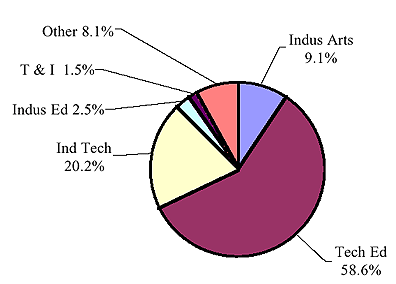
Figure 1 . Program name (what respondents call their programs). More than half (60.3%) associated their programs most closely with "general education" 3 very similar to the percentage reported two decades earlier in the SfIAP Project study (54%). Despite efforts throughout this century to place technology education in the general education arena (see, for example, Bonser and Mossman, 1923 ; Wilbur and Pendered, 1973 ) and the current "technology for all Americans" mantra, four programs in ten (39.7%) of the TEPS respondents felt their program was most closely associated with "vocational education," as had 36% in 1979. This might be because many technology education programs are still administered under "vocational education" administrative structures at the local and state levels.
Faculty Demographics and Professional Activity
The average number of faculty in programs surveyed was 2.5, a slight decline from the 2.8 average found by the SfIAP Project in 1979. While the shortage of women throughout the profession remains one of the most pressing problems confronting our field, there are about ten times more women teaching technology education today (10.1%) than the 1% reported by the SfIAP Project twenty years ago ( Figure 2 ). Nonetheless, technology education faculties are still overwhelmingly comprised of white (94.1%) men (89.9%).
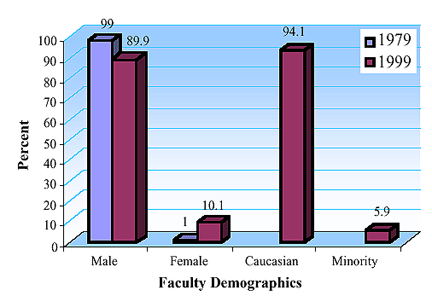
Figure 2 . Comparison of faculty demographics between 1979 and 1999. As many have surmised in recent years, the technology teaching workforce is aging. Technology faculty now average nearly twice as many years of experience (17.5) as reported by Schmitt and Pelley in 1963 ( Figure 3 ).
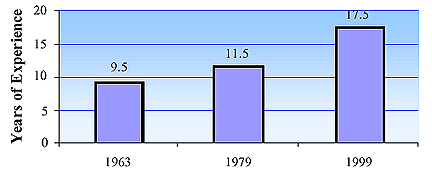
Figure 3 . Comparison of faculty experience over the past four decades. Technology education programs were more than twice as likely to have faculty with 25 years of teaching experience (24.7%) than with 6 or fewer years of experience (11.8%).
Faculty were about ten times more likely be in their 40s than in their 20s ( Figure 4 ). That said, only 7.4% of the faculty were reported as being over 55. The field may more likely be ready for a mid-life crisis than a retirement party.
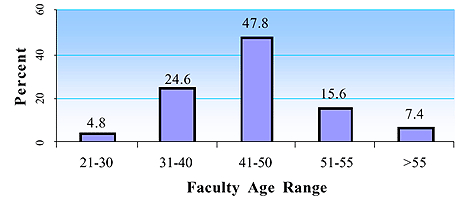
Figure 4 . Average age of faculty in technology education programs. There doesn't appear to be as many unlicensed technology teachers as many in the field seem to think. In fact, the percentage of unlicensed teachers in the field has hardly changed since the Schmitt and Pelley study in 1963. About 92% of the respondents were licensed in either technology education or industrial arts. This is only 2% less than the 94% reported in the two previous studies. As critical technology teacher shortages continue, we might expect to see a substantial increase in the number of unlicensed technology teachers in coming years.
About one fourth (24.2%) of the faculty were ITEA members, up slightly from the 22% of chairpersons surveyed in 1979. A relatively small percentage of technology education faculty participate in state and national conferences. About one in five (20.8%) had attended their state technology education conference each of the previous five years. About one in four faculty (26.8%) did not attend any state conferences over the same span. Fewer than one faculty member in five attended an annual Conference of the ITEA over the previous five years, and about 65% did not attend any ITEA Conferences in that five year span.
Student Demographics
Technology education is enrolling a more diverse population of students than did industrial arts. Although Bonser and Mossman ( 1923 ) and others have advocated industrial arts for all students since the early part of the twentieth century, in practice, industrial arts was almost exclusively for males. Females represented only 2.1% of those enrolled in industrial arts courses in 1963. In 1979, 16.8% of those enrolled in the 10 most-taught industrial arts classes were female (the overall percentage of female enrollment was not reported by the SfIAP Project). Though a very substantial gender-gap remains, technology education has made progress in this regard. The data suggest that one third (33.3%) of those now enrolled in technology education are female. Moreover, nearly half (46.2%) of middle school technology education students are female ( Figure 5 ). Similarly, females accounted for 43.5% of the enrollment in 318 middle school level general technology education courses listed in Part II of the TEPS. As shown in Figure 5 , female enrollments drop off radically at the high school level.
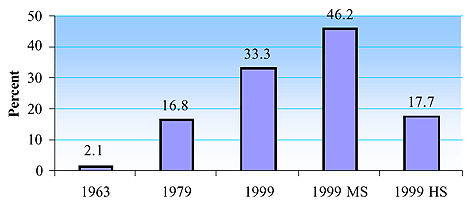
Figure 5 . Comparison of female student enrollments over the past four decades. On average, technology education programs are enrolling about half (51.8%) of the students in their schools, up from the 33.7% that the SfIAP Project reported in 1979 ( Figure 6 ). Technology education was required of all students in about four out of ten schools (39.3%) responding to the TEPS, and in nearly half (47.9%) of the middle school programs surveyed.
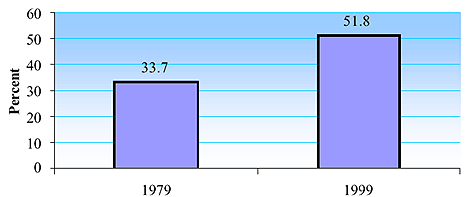
Figure 6 . The percentage of students served in 1979 and 1999. About one fourth (26.2%) of those enrolled in technology education are from minority populations, nearly identical to the percentage of minority persons in the general US population ( Westphal, 1999 ). This is up from the 18% reported in 1979, reflecting the general growth of minority populations in the US over the past two decades ( Figure 7 ).
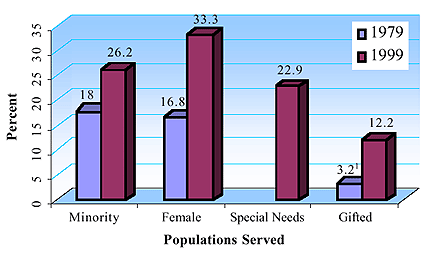
Figure 7 . Comparison of enrollment demographics between 1979 and 1999. Respondents indicated that 22.9% of those enrolled in their technology education courses were "special needs" students. It should be noted here that the phrase "special needs" was open for interpretation, and respondents may not have been fully qualified to answer this question-providing, instead, an educated guess. For purposes of comparison, the US Department of Education ( 1999 ) identified 11% of 6-21 year olds in the US as having "disabilities," though the terms "disabilities" and "special needs" have different meanings. At the other end of the spectrum, TEPS respondents identified 12.2% of their students as "gifted and talented." In contrast, guidance counselors surveyed by the SfIAP Project reported only about 3.2% of industrial arts students to be "above average" and only about .5% as "well above average."
Student Organizations and Advisory Committees
Participation in student organizations is on the rise. About twice as many programs reported having technology education student organizations (26.4%) than the 14% reported in both the 1963 and 1979 studies (See Figure 8 ). But fewer than one in ten (8.1%) were affiliated with the Technology Student Association (up slightly from the 5% affiliated with the American Industrial Arts Student Association (AIASA) in 1963 and the 4.6% reported in 1979). About one fourth of the technology education programs surveyed (23.4%) had an advisory committee.
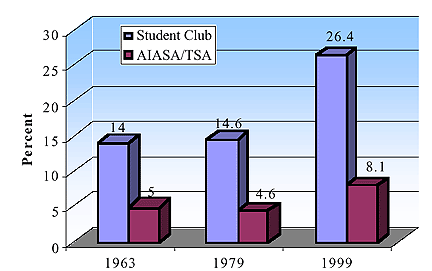
Figure 8 . Comparison of participation in student clubs/associations
over the past four decades.The Purposes of Technology Education
Respondents were asked to rate the importance of 16 different "purposes" of technology education on a scale from 1 to 10. Ten of these had appeared in the Schmitt and Pelley study ( 1963 ) and a dozen were included in the SfIAP Project ( 1979 ) study. Four new purposes were paraphrased from the "Program Goals for Technology Education" presented in A Conceptual Framework for Technology Education ( Savage and Sterry, 1990, p. 20 ) and added to this study. Table 2 shows a rank-order comparison of the purposes of technology education as reported in this study, the SfIAP Project data collected in 1979, and the Schmitt and Pelley Study of 1963.
There has been a noticeable shift in the perceived purposes of the field, from tool skills (industrial arts) to problem-solving (technology education). Each of the two earlier studies ranked "Develop skill in using tools and machines" as the number one purpose of industrial arts. But this purpose plummeted to the 11th of 16 options in this study. Similarly, "Provide technical knowledge and skill" dropped from second in 1979 to sixth in this study. At the same time, "Developing problem-solving skills," and "Use technology (knowledge, resources, and processes) to solve problems and satisfy human wants and needs" were ranked as the number one and two purposes respectively in this study. The latter didn't appear on either of the earlier studies, but was suggested in A Conceptual Framework for Technology Education ( Savage and Sterry, 1990, p. 20 ). Problem-solving was of moderate importance in industrial arts, ranking fifth in both the 1964 and 1979 studies.
The application of science and mathematics was essentially ignored in industrial arts education, ranking last in both 1963 and 1979, but ranked fourth (of 16 purposes) in this study. In practice, however, coordinating technology education with mathematics and science teachers is still relatively rare.
Table 2 Purposes of Technology Education Compared
Purposes of Technology Education Mean Rank 1979
Rank 11963
Rank 2
Develop problem-solving skills 1,2 8.94 1 5 5 Use technology (knowledge, resources, and processes) to solve problems and satisfy needs and wants 3 8.57 2 NA NA Make informed educational and occupational choices 1 8.28 3 7 NA Understand the application of science and mathematics 1,2 7.97 4 12 10 Develop an understanding of the nature and characteristics of technology 1 7.85 5 11 NA Provide technical knowledge and skill 1,2 7.75 6 2 4 Recognize that problems and opportunities relate to and often can be addressed by technology 3 7.63 7 NA NA Discover and develop creative talent 1,2 7.46 8 3 2 Identify, select, and use resources to create technology 3 7.34 9 NA NA Provide pre-vocational experiences 1,2 7.22 10 9 6 Develop skill in using tools and machines 1,2 7.14 11 1 1 Develop consumer knowledge and appreciation 1,2 6.68 12 8 9 Evaluate the positive and negative consequences of technological ventures 3 6.64 13 NA NA Understand technical culture 1,2 6.61 14 6 7 Develop worthy leisure time interests 1,2 5.73 15 4 3 Provide vocational training 1,2 5.55 16 10 8
1 From the SfIAP Project study; 2 From the Schmitt and Pelley study; 3 Paraphrased from A Conceptual Framework for Technology Education ( Savage and Sterry, 1990 ) Respondents indicated that only 13.3% of instruction, on average, was "interdisciplinary with math and/or science teachers."
The field is losing interest in the goal of helping students develop leisure time interests. This purpose ranked third in 1963 and fourth in 1979, but dropped to 15th (of 16) in this study.
Although Savage and Sterry ( 1990, p. 20 ) identified the "evaluation of the positive and negative consequences of technological ventures" as an important goal of technology education, it ranked very low (13th) in this study. In other words, practitioners perceive this to be a much less important purpose than did technology education leaders.
Recent Support for Technology Education
A series of questions asked about enrollment, staffing, and funding trends over the previous five years. Over that span, enrollments and class sizes in technology education programs were generally stable or on the rise ( Figure 9 ) and were roughly parallel to the overall school enrollment figures reported. Concurrently, funding support was reported to be either stable (48.1%) or in decline (30.2%) and the number of faculty, on whole, remained relatively stable. That is, technology education programs were just as likely to have increased their number of faculty (17.9%) over those five years as they were to have decreased in size (17.9%). The relatively level funding and faculty numbers, juxtaposed with increasing enrollments, class size, and inflation during this five-year span, suggests a net loss in "buying power" in recent years. Not surprisingly, the most significant barrier to having an outstanding program reported was lack of financial support.
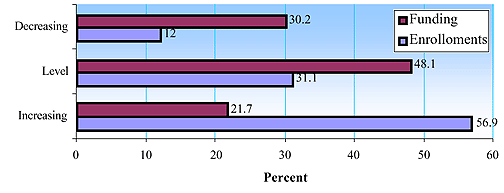
Figure 9 . Funding and enrollment trends over the past five years. Research Question #2: To what extent are technology education programs using content and method promoted in the recent literature of the profession?
Methods of Instruction
Problem-solving methodologies have been heavily promoted in the literature. Practitioners seem to have taken notice. As already mentioned, problem-solving was the focus of the top two purposes identified. Moreover, the data indicate that more than half (56.9%) of the instruction delivered "engages students in problem-solving" and a full third of the programs surveyed (32.7%) devote 80-100% of their instruction to problem-solving activities. On a related note, the field remains committed to hands-on instruction; only about one fourth (22.8%) of instruction was identified as "lecture/demonstration" (i.e., not hands-on activity).
The application of computers in the curriculum is another area receiving attention in the literature and the data suggest that computers have, in fact, become an important component of technology education. About nine out of ten (88.6%) technology education programs employ computer-based instructional activities. On average, 40.1% "used a computer as a tool to complete an activity or project, solve a problem, etc." which suggests computer use in technology education goes well beyond the word processing or Web searching that seem to characterize most computer use in K-12 education. Moreover, 60.8% indicated some means of Internet access from their technology education laboratory. Each of these indicators signals a departure from traditional woodworking, metalworking, and drafting for which industrial arts was best known in the past.
The pros and cons of "modular technology education" have been a recurring source of analysis and debate (see, for example, Petrina, 1993 ; Foster, 1994a ; Brusic and LaPorte, 2001 ). Just how prevalent is the modular approach? Respondents were asked which of the following best described their facilities: "Unit Labs (e.g., Woods, Electronics, Drafting); Systems Labs (e.g. Production, Communication, Transportation); General Labs (wide mix of equipment in each lab); or Modular Labs (e.g., Synergistics, etc.)." While about one-sixth described their facilities as modular, the unit and general laboratories popular throughout the past century are still more prevalent than modular laboratories ( Figure 10 ).
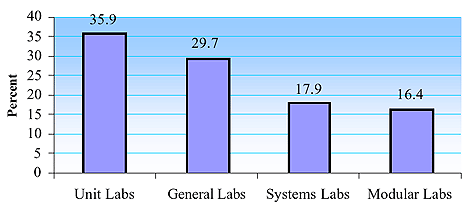
Figure 10 . The descriptor that best described the program's facilities. On the other hand, about half of the programs (48.5%) had some type of "vendor-created modular work stations" and nearly three quarters (72.5%) utilized "teacher-created modular work stations" ( Figure 11 ). So most programs have implemented modular instructional methodology to some extent. Teacher-made modules accounted, on average, for 31.4% of program facilities and vendor-made modules accounted, on average, for 20.7% of all facilities.
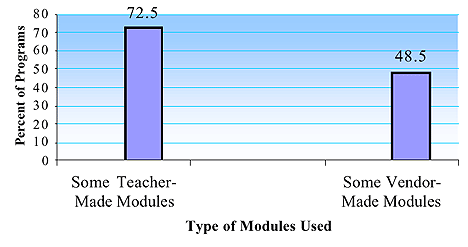
Figure 11. Teacher-made and vendor-made modules used in programs. It appears there is no one dominant instructional approach to technology education. Respondents were asked to identify the "teaching approach most used" in their programs. As Figure 12 indicates, there was a fairly even split among the modular approach (35.4%; divided between "vendor-created" and "teacher-created"), the project approach (27.9%; "projects from plans provided by instructors"), and a design and technology approach (36.7%; "students design and build solutions to problems posed by instructors"). Looking at it another way, nearly three-fourths of instruction does not utilize the project (from plans) method that was popular during the industrial arts era.
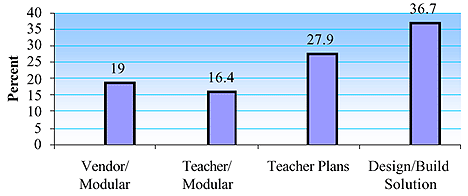
Figure 12 . Respondents were asked to select the "most used instructional
approach" from these four options.Instructional Content
The Conceptual Framework for Technology Education ( Savage and Sterry, 1990, p. 14 ), widely distributed by the ITEA, promoted four major "technological processes" (commonly referred to in the field as "content "organizers"): communication, production, transportation, and bio-related technology processes. A series of questions on Part I of the TEPS asked respondents the percentage of their total instructional content represented by each of these four organizers. Production and communication make up the majority of the curriculum ( Figure 13 ). Transportation is more modestly represented, while bio-related technological processes remain almost non-existent in the curriculum.
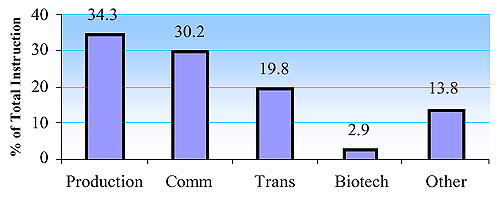
Figure 13. Respondents were asked to divide the content taught in their program
into these five categories (such that their total equaled 100%).Research Question #3: What courses are currently being used in technology education programs and what do these course titles suggest about the profession?
Part two of the TEPS asked respondents to list all courses taught in their programs, along with course duration and enrollment data. This resulted in a list of 1,756 courses. Because of the plethora of specific course titles, and in an attempt to compare current course title trends with the Schmitt and Pelley data of 1963 and the SfIAP Project data of 1979, course titles were grouped into categories with names similar to those used in the earlier studies. These, and some newly identified course categories appear in Tables 3 and 4 .
As shown in Table 3 , surprisingly little change has occurred in the ranking of the top ten course categories taught over the past four decades. Because of large middle school enrollments, the "General Technology Education" course category was the most often taught category in 1999, as was "General Industrial Arts" in 1963 when Schmitt and Pelley surveyed the profession. If "Architectural Drawing/Architectural Drafting" (1999, Rank 5) is combined with "Drafting/CAD" (1999, Rank 2) as apparently had been done with "Architectural Drafting" and "Drafting" in 1963, and if "Graphic Communications" (1999, Rank 10) is combined with "Communications" (1999, Rank 8), the top six course categories in 1999 would be the same as the top six course categories taught in 1963.
Table 3 The 10 Most-Taught Course Categories in Technology Education/Industrial Arts
Rank 1999 1 1979 2 1963 3
1 General Tech Ed (429) 4 General Woods General IA 2 Drafting/CAD (261) General Metals Woodworking 3 Wood Technology (180) Mechanical Drawing Drafting 4 Metal Technology (74) Drafting Metalworking 5 Arch Draw/Arch Draft (70) General Industrial Arts Graphic Arts 6 Electricity/Electronics (62) Architectural Drafting Electricity/Electronics 7 Manufacturing (57) Graphic Arts Crafts 8 Communications (53) Auto Mechanics Power Mechanics 9 Automotives (49) Electricity Home Mechanics 10 Graphic Comm (45) Woodworking Photography
1 From this study; 2 From SfIAP Project; 3 From the Schmitt and Pelley study; 4 The number in ( ) indicates the number of courses conglomerated to create this category Table 4 shows the "second ten" most-taught course categories. Course titles that included the "contemporary" nomenclature-Manufacturing, Communications, Construction, and Transportation-made their way into the "top 12" most-taught course categories in 1999. Interestingly, "bio" (as in "biotechnology" or "bio-related") appeared only four times, and "Design and Technology" appeared only once among the 1,756 titles listed.
Table 4 The 11th-20th Most-Taught Course Categories in Technology Education
Rank Course Title
11 Construction (35) 1 12 Transportation (35) 13 Materials and Processes (34) 14 Power (title implied automotive rather than energy) (24) 15 Welding (24) 16 Photography (21) 17 Modular Technology Education (20) 18 Computers (20) 19 Principles of Technology (19) 20 Architecture ["drawing/drafting" not used in title] (17)
1 The number in ( ) indicates the number of courses in this category Summary and Conclusions
Is current technology education practice in the US reflective of a "new paradigm" that Clark ( 1989 ) and others have proposed or, is it more reminiscent of old wine in a new bottle, as Petrina and Volk ( 1995 ) concluded? This study provides evidence that substantive changes have taken place in technology education practice, particularly with respect to program names, the purposes of the field, students served, and instructional methods employed. But the magnitude of change pales in comparison with the shift from Ptolemy's view of the universe (with the earth at the center) to the Copernican view (with the sun at the center). The data suggest a decided, evolutionary shift-with the legacy of industrial arts still in evidence-rather than a total transformation of the field.
Programs calling themselves "technology education" now outnumber "industrial arts" programs six to one, with "industrial technology" claiming most of the middle ground. By and large, program names have changed. But names can be superficial. The more important question is, "How does the substance of technology education practice differ from that of the industrial arts era"?
One of the more telling shifts is in the perceived purposes of technology education. Practitioners report the teaching of problem-solving as the most important purpose of the field, supplanting the emphasis on skill development found in the two major previous studies. "Problem-solving" may be interpreted many different ways, so further research is necessary to clarify the nature of this particular shift. But the declining emphasis on tool skills sends a clear signal that technology education practitioners are thinking differently today than in decades past about the primary purposes of technology education.
Instructional method is another area of substantive change. Building projects from plans provided by instructors, an approach popular in the post World War II era, is still the preferred approach in about one program in four. But "modular technology education" and "technological problem-solving," an approach in which students design and build solutions to problems posed by the teacher, are now more widespread than the project-from-plans method. That is, roughly three programs in four are using either the modular technology education or technological problem-solving approach to instruction, while one program in four prefers the project-from-plans method.
Significant demographic shifts have transformed the faculty and students of technology education, and the field is reaching a greater range and percentage of students than ever. While only one faculty in ten is female, this is ten times the percentage reported two decades ago. Similarly, one third of technology education students enrolled are female, about fifteen times the percentage of the early 1960s. Technology educators teach a high percentage of special needs students, and far more "gifted and talented" students, than did industrial arts programs in previous decades. Minority students comprise one fourth of technology education enrollments, paralleling the minority proportion in the general population.
Despite these demographic shifts, technology education is still taught mostly by middle-aged white men. The implications of an aging white male faculty at a time when the field is promoting "technology education for all" are obvious and must not be overlooked . Perhaps the good news is that increasing female and minority enrollments provide a larger pool from which to recruit future technology teachers. But since relatively few females take technology education courses beyond their middle school years, the field must find new ways to encourage female students to pursue technology education during high school, and technological careers-including technology education-thereafter. Similarly, the goal of "technology education for all" suggests a need for new strategies for recruiting minority populations into technology teacher education programs. As technology education continues to search for solutions to the growing teacher shortage, female and minority technology education students offer obvious and untapped potential.
For decades, the literature has encouraged new content for technology education, and the findings of this study suggest that communication, manufacturing, construction, and transportation technologies are increasingly represented in the curriculum. On the other hand, biotechnology clearly has not gained "market share" in the curriculum, despite ten years of encouragement from the profession. This forebodes the challenges that lie ahead as the field begins to address the new content areas stipulated in the Standards for Technological Literacy ( itea, 2000 ).
There seems to be continued ambivalence regarding the relationship of technology education to vocational and general education. Despite efforts throughout the past century to distance technology education from vocational education, there is considerable evidence in this study of the sort of "border crossings" to which Lewis ( 1996 ) alluded. Four programs in ten still associate with vocational education, a slightly higher percentage than did so in 1979. This is probably because many technology education programs are currently administered and funded through departments of vocational education. Drafting/CAD-the most-taught high school technology education course category-is arguably vocational in nature, particularly when taught in the popular two- or three-course sequence. On the other hand, respondents ranked the two vocational purposes tenth and last in the list of 16 purposes for technology education. These waters are muddy; the absence of meaningful dialogue within the profession regarding the relationship between technology education and vocational education has led to continuing confusion both within and beyond the field. It is time the profession addressed this issue in an articulate and thoughtful manner.
As clichés go, neither old wine nor new paradigm seems to best describe current practice in technology education in the US. It's more like "something old, something new, something borrowed " Considerable change has been taking place over the past few decades, but the legacy of industrial arts is also evident throughout the data. The dynamic between change and legacy seems to characterize the field at this point in time; technology education is a work-in-progress.
Acknowledgement
This study was supported, in part, by a grant from the Technical Foundation of America.
Notes
1 Although Warner's 1947 AIAA Conference presentation has commonly been cited as "A Curriculum to Reflect Technology," Latimer ( 1974, p. 71 ) found evidence that the 1947 paper was originally titled "The New Industrial Arts Curriculum." In 1959, Epsilon Pi Tau published a nearly identical paper titled "The Industrial Arts Curriculum: Development of a Program to Reflect American Technology." The term "technology" may have initially made its way into a revision of this paper as early as 1953. In 1965, Epsilon Pi Tau published a version of the paper titled "A Curriculum to Reflect Technology," with a subtitle that reads "AIAA Feature Presentation 15 April 1947," which is likely why it has generally been cited under this title with the 1947 publication date.
2 The note at the top of the survey instrument outlined with a border, read, "This survey is intended only for those who teach or supervise Technology Education/Industrial Arts (TE/IA). If you do not, please give this survey to the TE/IA Chairperson in your school. If no such teacher, please return it in the postage-paid envelope. Thanks!"
3 In order to maintain consistency with the earlier SfIAP Project study, four options were provided for this question: General Education (55.2%), Preparation for a College Education (5.1%), Preparation for Vocational/Technical Education (23.4%), and Vocational/Technical Education (16.3%). For reporting purposes, the first two categories were combined into "General Education" and the latter two were combined into "Vocational Education."
References
Bonser , F. &Mossman, L. (1923). Industrial arts for elementary schools . New York: MacMillan.
Bowden , T. ( tdedit@techdirections.com ). (2000, March 20). Tech Directions Circulation . E-mail to Mark Sanders ( msanders@vt.edu ).
Breakwell , G. M., Hammond, S. &Fife-Schaw, C. (Eds.). (1995). Research methods in psychology . London: Sage Publications.
Brusic , S. A. &LaPorte, J. E. (2001). The status of modular technology education in Virginia. Journal of Industrial Teacher Education . 38(1), 5-28 .
Clark , S. C. (1989). The industrial arts paradigm: Adjustment, replacement, or extinction? Journal of Technology Education , 1(1), 7-21 .
DeVore , P. W. (1964). Technology: An intellectual discipline . Washington, DC: American Industrial Arts Association. (Bulletin Number 5).
Dugger , W. E., Miller, C. D., Bame, E. A. Pinder, C. A., Giles, M. B., Young, L. H., and Dixon, J. D. (1980). Report of the Survey Data . Blacksburg, VA: Virginia Polytechnic Institute and State University.
Dugger , W. E., Fowler, F., Jones, A., and Starkweather, K. (1986, September). School shop readers report their view of the profession. School Shop/Tech Directions , p. 19-24.
Dugger , W. E., French, B. J., Jones, A., and Starkweather, K. (1990, January). Fifth annual survey of the profession shows changes and challenges. The Technology Teacher , p. 27-34.
Dugger , W. E., French, B. J., Peckham, S., and Starkweather, K. (1991, February). Sixth annual survey of the profession shows changes and challenges. School Shop/Tech Directions , p. 21-23.
Dugger , W. E., French, B. J., Peckham, S., and Starkweather, K. (1992, January). Seventh annual survey of the profession: 1990-91. The Technology Teacher , p. 13-16.
Foster , P. N. (1994a). Must we MST? Journal of Technology Education , 6(1), 76-84 .
Foster , P. N. (1994b). Technology education: AKA industrial arts. Journal of Technology Education , 5(2), 15-30 .
International Technology Education Association. (1996). Technology for all Americans: A rationale and structure for the study of technology . Reston, VA: Author.
International Technology Education Association. (2000). Standards for Technological Literacy: Content for the Study of Technology . Reston, VA: Author.
Jones , A. H., Peckham, S., and Miller, S. K. (1985, August). School shop survey draws 1319 responses. School Shop, pp. 21-23.
Krecjie , R. V. &Morgan, D. W. (1970). Determining sample size for research activities. Educational and Psychological Measurement , 30, 607-610.
Latimer , T. G. (1974). William Everett Warner: Innovative pioneer of industrial arts . Unpublished doctoral dissertation, North Carolina State University.
Lewis , T. (1996). Accommodating border crossings. Journal of Industrial Teacher Education , (33)2, 7-28 .
McCormick , R. (1992). Evolution of current practice in technology education: Part I. Journal of Technology Studies , (18)2, 19-28.
Petrina , S. (1993). Under the corporate thumb: Troubles with our MATE (modular approach to technology education). Journal of Technology Education , 5(1), 72-80 .
Petrina , S. (1998). The politics of research in technology education: A critical content and discourse analysis of the Journal of Technology Education, Volumes 1-8. Journal of Technology Education , 10(1), 27-57 .
Petrina , S. and Volk, K. (1995). Industrial arts movement's history, vision, and ideal: Relevant, contemporary, used but unrecognized-part II. Journal of Technology Studies , 21(2), 28-35.
Sanders , M. E. (1999a). Status of technology education in the public schools: Preliminary report . Paper presented at the Annual Conference of the International Technology Education Association. Indianapolis, IN.
Sanders , M. E. (1999b). Technology education programs survey . Unpublished survey instrument, Virginia Tech, Blacksburg, VA.
Savage , E. and Sterry, L. (1990). A Conceptual Framework for Technology Education . Reston, VA: International technology education Association.
Scarborough , J. D. (1989). The changing content of technology education curricula. The Technology Teacher , 48(7), 5-8.
Schmitt , M. L. &Pelley, A. L. (1966). Industrial arts education: A survey of programs, teachers, students, and curriculum. U. S. Department of Health, Education, and Welfare ,. OE 33038, Circular No. 791. Washington, DC: Office of U.S. Government Printing Office.
U.S. Department of Education (1999). Twenty-first annual report to Congress on the implementation of the Individuals with Disabilities Act . Washington, D.C: Author.
Warner , W. E. [with Gary, J. E., Gerbracht, C. J., Gilbert, H. G., Lisack, J. P., Kleintjes, P. L., and Phillips, K.]. (1947, April). The new industrial arts curriculum . Paper presented at the first meeting of the American Industrial Arts Association, Columbus, OH.
Warner , W. E. (1959). The industrial arts curriculum: Development of a program to reflect American technology . Columbus, OH: Epsilon Pi Tau.
Westphal , D. (1999, Sept 15). 1 in 4 in U.S. is minority . The News Observer on the Web. http://www.news-observer.com/daily/1999/09/15/nc01side1.html .
Wilbur , G. O. &Pendered, N. C. (1973). Industrial arts in general education . NY: Intext Educational Publishers.
Yu , K C. (1991). A Comparison of Program Goals Emphasized in technology education Among Selected Groups of Professionals in the State of Virginia . Unpublished doctoral dissertation, Virginia Polytechnic Institute and State University.
Mark Sanders ( msanders@vt.edu ) is a faculty member in the Technology Education Program at Virginia Polytechnic Institute &State University, Blacksburg, VA.